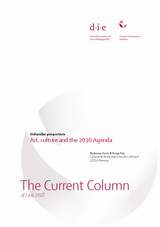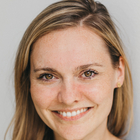Unfamiliar perspectives
Art, culture and the 2030 Agenda
Sturm, Janina / Ronja FitzThe Current Column (2018)
Bonn: German Development Institute / Deutsches Institut für Entwicklungspolitik (DIE), The Current Column of 2 July 2018
Bonn, 2 July 2018. How do Cuban artists come up with the idea of turning a table upside down and using it as a boat in the Caribbean Sea? The video installation of artist couple Jennifer Allora and Guillermo Calzadilla is a reference to the Puerto Rican island of Vieques, which was used by the US as a base and training location for over 60 years. Weapons testing was carried out on this seemingly idyllic Caribbean island for more than five decades. The results are a landscape pockmarked with bomb craters and an ecosystem polluted with materials including lead and mercury. The inhabitants of the island were robbed of their livelihood. Local civic initiatives are calling for justice and compensation from the US government. So far the inhabitants of Vieques have not been granted a hearing. The two Puerto Rican-based artists aim to change this: the overturned negotiating table urges balanced communication and non-violent conflict resolution. The picture also forms the title image of the exhibition ”Zur Nachahmung empfohlen! – Expeditionen in Ästhetik und Nachhaltigkeit“ (“examples to follow! - expeditions in aesthetics and sustainability”), currently on show in Bonn. What role can art and culture play in the transformation to sustainable development? Creating a livelihood for all and maintaining this sustainably is the key concern of the 2030 Agenda for Sustainable Development, adopted in 2015. With this agreement, all states committed themselves to achieve the 17 goals (Sustainable Development Goals, SDG) contained therein. The agenda constitutes a major step forward, as it commits industrialised, emerging and developing countries alike to transformation. In addition, the goals are not limited to a specific number of issues, but instead require progress in all dimensions of sustainable development, i.e. ecological, economic, social but also political and cultural areas. With SDG 4 “Quality Education”, in particular the agenda states the significance of a cultural basis for sustainable development. Here and at further points, the agenda emphasises the significance of cultural diversity in particular in achieving the SDGs. Since the adoption of the agenda three years ago, numerous countries have formulated declarations of intent for the implementation of the goals, however, in Germany, Europe and worldwide we are still far from achieving these. There is growing concern that the implementation might stuck in bureaucratic and diplomatic processes, which would hinder a comprehensive transformation. Beyond executive authority and diplomacy, the response from society and business with regard to the 2030 Agenda for Sustainable Development is still insufficient. Although the agenda is used as a point of reference in individual areas, too often sustainability is still reduced to ecological issues or technical innovations, thus far playing no significant role in either public discussion or political programmes. In Germany, too, the 2030 Agenda has failed to establish itself as a core principle and central element in politics and business. As the artists Allora and Calzadilla and the exhibition “examples to follow! – expeditions in aesthetics and sustainability“ impressively illustrate, art has the unique ability to visualise interrelations and appeal to people at an emotional level. Art and culture should be regarded as a key medium between complex challenges and social actors. Building bridges between art and culture on the one hand and science on the other also serves diverse mutual enrichment. As a result, with the aid of the cultural dimension, complex issues can be rendered accessible and a shift in perspective can draw attention to the theme of sustainability. The aforementioned exhibition or the annual “Concert for a Sustainable Planet” at New York’s Carnegie Hall aim to promote dialogue and inspire activities. Art can open up unusual perspectives, provide a platform for issues and lend visibility to things that are often not seen at first glance. In Germany, the establishment of a fund for aesthetics and sustainability (Fonds für Ästhetik und Nachhaltigkeit) has long been supported by leading figures in public life. The combination of art and science can open up new doors to a sustainable future. Janina Sturm and Ronja Fitz, Sustainable Development Solutions Network (SDSN) Germany


